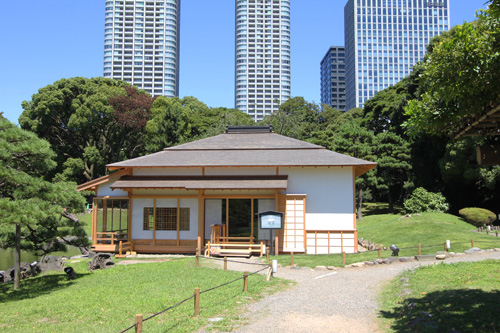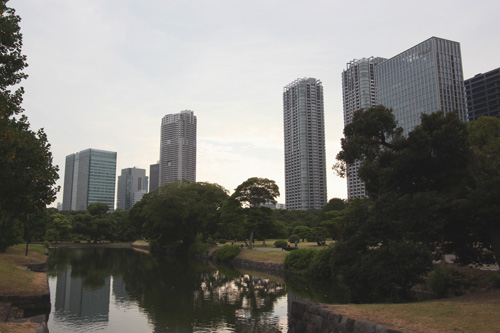Garden History
- Published 2015.7.28

Origin: The idea for Traditional Japanese Gardens first originated from the Asuka period when Japanese merchants saw the gardens in China being built. Later, Japanese gardens first appeared on Honshu, the main island of Japan. The traditional gardens were also heavily influenced by the characteristics of the Honshu landscape which consisted of rugged volcanic peaks, narrow valleys & mountain streams with waterfalls & cascades, lakes, and beaches surrounded by pebbles.
Early Japan (0-794): One of the earliest forms of gardens in Japan were scared places in nature where humans marked specific areas with pebbles. This garden form can be recognized at some ancient Shinto shrines where buildings are surrounded by wide pebbled areas. Gardens were then made to be pleasure gardens for Japanese Emperors and nobles later during this time. The development of the Japanese style gardens were significantly affected by Buddhism and Daoism.
Heian period (794-1185): Gardens during the Heian period had 3 types of variations; palace gardens & gardens of nobles in the capital, gardens of villas at the edge of the city, and temple gardens. These gardens all closely resembled Chinese gardens as the architecture of palaces, residences, and gardens all followed Chinese designs. The Japanese gardens at this time were mainly built around palaces and villas, which was known as Shinden Gardens. They were built over large areas and were used for parties and activities such as boating, fishing, and general enjoyment. Later during the Heian period, Pure Land Buddhism became increasingly popular and gardens with lotus flowers and islands with pavilions resembling the Western Paradise of Amida Buddha or Pure Land were built.
Kamakura and Muromachi Periods (1185-1573): Gardens during this time were usually attached to temple buildings to help monks in their meditation and religious advancements rather than for recreational purposes. This had a strong influence on the design of the gardens, changing the layouts and many different aspects. Most gardens became smaller, simpler, and more minimalistic due to religious purposes while retaining previous aspects such as ponds, islands, bridges and waterfalls. The Karesansui Dry Garden (related to Zen Buddhism) was a huge development towards minimalism by using nothing but rocks, gravel, and sand to represent all elements of the garden landscape.

Azuchi-Momoyama Period (1568-1600): The Azuchi-Momoyama Period was the height of tea ceremonies that were held in tea gardens (chaniwa). The contemporary tea masters refined and perfected the Japanese garden design and imbued it with the spirit of "wabi", rustic simplicity. This resulted in more simplistic and utilitarian designs in gardens usually containing a stepping stone path leading to the entrance of the tea house. Stone lanterns were incorporated into the garden design by providing lighting and decorative element with wash basins (tsukubai) that were used for ritual cleansing. Gardens from the Azuchi-Momoyama period were also later incorporated into larger garden designs. Many of the gardens were part of the fortified castles of the daimyo (leaders of the feudal Japanese clans). These gardens contained one or more ponds or lakes next to the main residence and were close to the shoin (audience hall developed during the Muromachi period). These Japanese gardens were also meant to be seen from the castle or residence and contemplated from a distance. The Daimyos also developed the skills of cutting and lifting large rocks (by using armies of soldiers) to build castles. These large rocks were displayed in gardens with artificial lakes surrounded by beaches of small stones and natural stone bridges and stepping stones.
Edo Period (1603-1868): Gardens during this time differed greatly from the minimalism of the Muromachi period. The Ruling class rediscovered likings for extravagance and recreation resulting in the creation of large strolling gardens with varieties of viewpoints along circular trails with elements of tea gardens. Tsuboniwa (ÕجÕ║Ł), small gardens, became popular among urban population. They were small gardens that filled small courtyard spaces within or between townhouses in the cities providing a small touch of nature with light and fresh air. Due to their small size, they featured small amounts of decorative elements and were made to be viewed and not entered.
Meiji Period (1868-1912): During the Meiji Period, Japan entered a time of rapid modernization and Westernization leaving many of the old private gardens to be abandoned and left to ruin resulting in a movement for the preservation of gardens from the Momoyama and Edo period. The gardens were transformed into public parks while preserving their original aspects. Western style parks were also built and formerly private strolling gardens were opened to public.
Modern Gardens (1912-now): During the Showa period (1926-1988) traditional gardens were built by businessmen and politicians, and not Emperors and nobles. After WWII, principal builders of gardens were no longer private individuals but banks, hotels, universities, government agencies. With this pattern, gardens became extensions of the architecture of buildings. New gardens were also being designed by architecture school graduates who used modern building materials like concrete, altering the visual aspects of traditional gardens.
